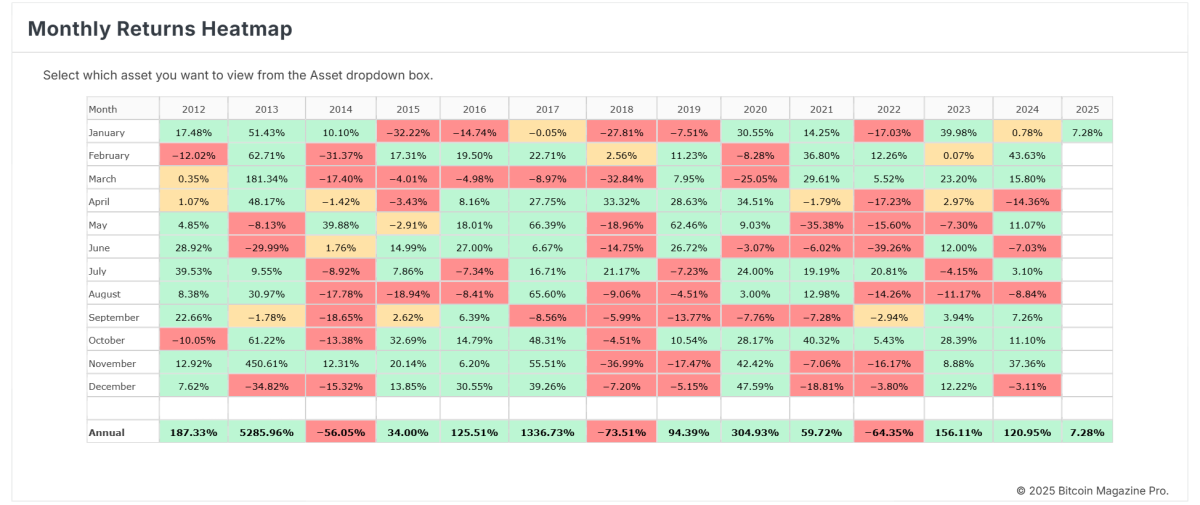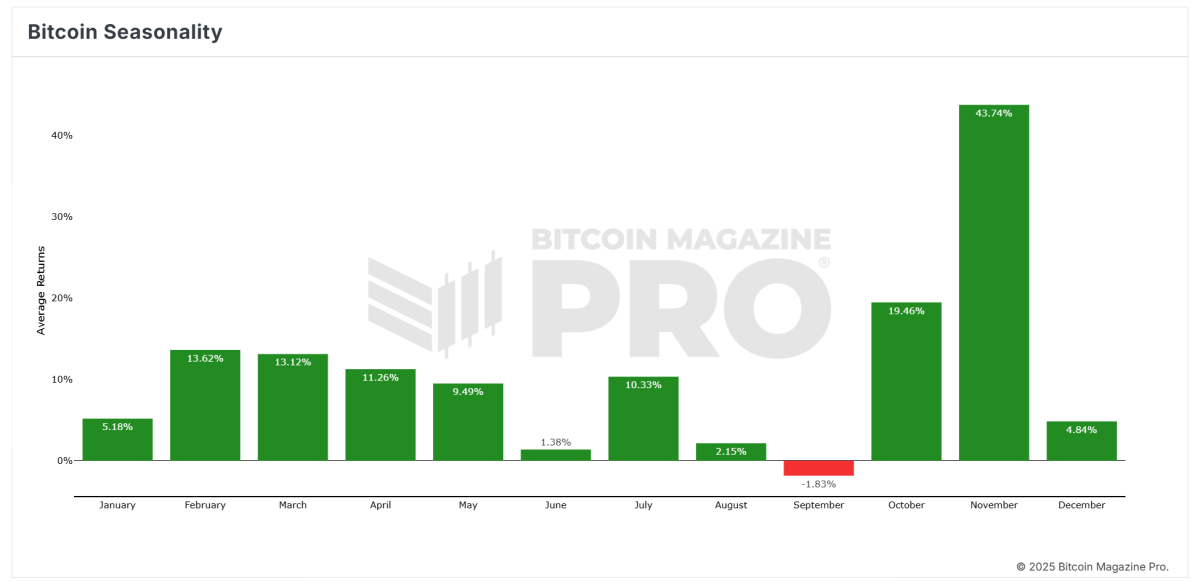As the Bitcoin market enters 2025, investors are eagerly analyzing seasonal trends and historical data to predict what February may hold. With Bitcoin’s cyclical nature often linked to its halving events, historical insight provides a valuable roadmap for navigating future performance. By examining historical data – including Bitcoin’s average monthly returns and its performance after the February halving – we aim to provide a clear picture of what February 2025 might look like.
Understanding Bitcoin’s Seasonality
The first diagram, “Bitcoin Seasonal,” highlights average monthly returns from 2010 to the most recent monthly close. The data underscores Bitcoin’s best-performing months and its cyclical trends. Historically, February has an average return of 13.62%and ranks it as one of the strongest months for Bitcoin performance.
It is noteworthy that November stands out with the highest average return on 43.74%followed by October at 19.46%. Conversely, September has historically been the weakest month with an average return of -1.83%. February’s solid average places it in the top tier of Bitcoin’s seasonal swing, giving investors hope for positive returns in early 2025.

Historic performance of February in post-half year
A deeper dive into Bitcoin’s historic February returns reveals fascinating insights into the years that follow a halving event. Bitcoin’s halving mechanism — which occurs roughly every four years — cuts block rewards in half, creating a supply shock that has historically driven price increases. February results in these post-halving years have consistently been positive:
- 2013 (after 2012 halving): 62.71%
- 2017 (after 2016 halving): 22.71%
- 2021 (halving after 2020): 36.80%
The average return over these three years is impressive 40.74%. Each of these Februarys reflects the bullish momentum that often follows halving events, driven by reduced Bitcoin supply issuance and increased market demand.
Related: We Replay the 2017 Bitcoin Bull Cycle
January 2025’s performance sets the stage
While February 2025 has yet to unfold, the year began on a modest note 7.28% return to date in Januaryas shown in “Monthly return Heatmap.” January’s positive performance suggests a continuation of bullish sentiment in the early months of 2025, consistent with historical post-halving patterns. If February 2025 follows the trajectory of previous post-halving years, it could see returns in the order of 22% to 63%with an average expectation of approx 40%.
What’s driving February’s strong post-halving performance?
Several factors contribute to February’s historical strength in the post-halving years:
- Supply shocks: The halving reduces new Bitcoin supply entering circulation, increasing scarcity and driving price appreciation.
- Market Momentum: Investors often react to the halving event with increased enthusiasm, pushing up prices in the months following the event.
- Institutional interest: In recent cycles, institutional adoption has accelerated post-halving, adding significant capital inflows to the market.
Key takeaways for February 2025
Investors should approach February 2025 with cautious optimism. Historical and seasonal data suggest that the month has strong potential for positive returns, especially in the context of Bitcoin’s post-halving cycles. With an average return of 40.74% in recent February post-halving, investors can expect similar results this year, barring significant macroeconomic or regulatory headwinds.
Conclusion
Bitcoin’s history provides a valuable lens through which to view its future performance. February 2025 is shaping up to be another positive month, driven by the same post-halving momentum that has historically fueled impressive gains. Combining historical data performance with a positive regulatory environment, the incoming pro-Bitcoin administration, and the news that the Financial Accounting Standards Board (FASB) has issued new guidance (ASU 2023-08) that fundamentally changes how Bitcoin is accounted for (Why Hundreds of Companies Will Buy Bitcoin in 2025), 2025 is shaping up to be a transformative year for Bitcoin. As always, investors should combine this insight with broader market analysis and remain prepared for Bitcoin’s inherent volatility.
Related: Why Hundreds of Companies Will Buy Bitcoin in 2025
By leveraging the lessons of history and seasonal patterns, Bitcoin investors can make informed decisions as the market navigates this pivotal year.
Visit bitcoinmagazinepro.com to explore live data and stay informed about the latest analysis.
Disclaimer: This article is for informational purposes only and should not be considered financial advice. Always do your own research before making investment decisions.
